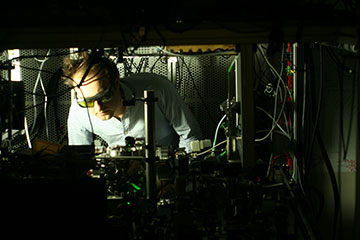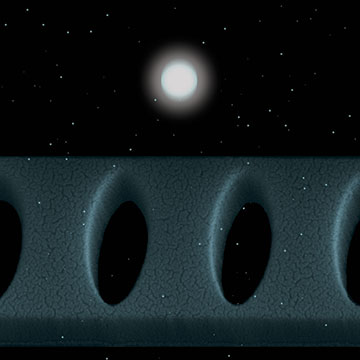
Lorenzo Magrini in the physics laboratory at the University of Vienna. [Image: Lorenzo Magrini, University of Vienna]
For 90 years, physicists have known that the uncertainty principle imposes fundamental limits on our knowledge of a quantum-sized particle’s position and momentum. Researchers at two European universities are pushing these limits by designing a new, tunable optomechanical trap to measure and control a levitated nanoparticle (Optica, doi: 10.1364/OPTICA.5.001597).
Laying the trap
Optical traps, of course, use a tightly focused laser beam to manipulate micron-sized and smaller objects; OSA Honorary Member Arthur Ashkin recently shared the Nobel Prize for his invention and subsequent pioneering studies of such devices. The team at the University of Vienna, Austria, and Delft University of Technology, the Netherlands, coupled the movements of the floating nanoparticle to a photonic crystal cavity placed a few hundred nanometers away. The coupling between the particle’s displacement and the phase fluctuations within the cavity allowed the scientists to make highly sensitive measurements of the particle’s motion.
The researchers built the photonic crystal out of silicon nitride deposited onto a silicon substrate, with a fundamental resonance frequency of 1538.72 nm. They attached it to an optical fiber inside a vacuum chamber. Tight focus of a 1064-nm laser trapped the dielectric silica particle, with a diameter of roughly 143 nm, within the interference between the beam itself and its reflection from the photonic crystal’s surface.

Artist’s depiction of a nanoparticle positioned near a photonic crystal cavity. [Image: Lorenzo Magrini, University of Vienna]
The team then positioned the photonic crystal about 310 nm away from the trapped particle. Since the evanescent field around the photonic crystal decays exponentially with distance from the cavity, small shifts in the position of the particle greatly change the propagation of light through the crystal. Scientists could control the particle’s position by tilting a dichroic mirror in the path of the trapping beam.
Future improvements
The system exhibits low optical losses, resulting in high sensitivity—its displacement sensitivity per photon is more than two orders of magnitude higher than an older method called far-field detection, the authors claim. The researchers have several ideas for improving the optomechanical controls, including rigid mounting of photonic crystal cavities onto a chip instead of a glass fiber.
